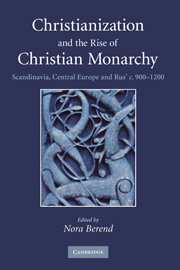Book contents
- Frontmatter
- Contents
- Contributors
- List of maps
- Acknowledgements
- Note
- List of common abbreviations
- Chapter 1 Introduction
- Chapter 2 From paganism to Christianity in medieval Europe
- Chapter 3 The kingdom of Denmark
- Chapter 4 The kingdom of Norway
- Chapter 5 The kingdom of Sweden
- Chapter 6 Bohemia and Moravia
- Chapter 7 The Kingdom of Poland, with an Appendix on Polabia and Pomerania between paganism and Christianity
- Chapter 8 The kingdom of Hungary
- Chapter 9 Rus'
- Index
- References
Chapter 8 - The kingdom of Hungary
Published online by Cambridge University Press: 24 June 2009
- Frontmatter
- Contents
- Contributors
- List of maps
- Acknowledgements
- Note
- List of common abbreviations
- Chapter 1 Introduction
- Chapter 2 From paganism to Christianity in medieval Europe
- Chapter 3 The kingdom of Denmark
- Chapter 4 The kingdom of Norway
- Chapter 5 The kingdom of Sweden
- Chapter 6 Bohemia and Moravia
- Chapter 7 The Kingdom of Poland, with an Appendix on Polabia and Pomerania between paganism and Christianity
- Chapter 8 The kingdom of Hungary
- Chapter 9 Rus'
- Index
- References
Summary
BEFORE CHRISTIANITY: RELIGION AND POWER
A Hungarian-speaking population, probably together with Turkic speakers, gradually conquered and settled the Carpathian Basin from the end of the ninth century onwards, after being attacked by Pechenegs. Scholars have speculated about the route and chronology of their migrations, about the ethnogenesis of the Hungarians and their social and political structure, with widely varied results. No firm evidence exists before the ninth century. Even the sources for the period between the ninth and eleventh centuries are extremely fragmentary and controversial, therefore most interpretations remain open to debate.
Pre-Christian religious beliefs have been reconstructed as animistic-shamanistic by scholars, based on analogies, linguistic evidence (the dating of which is problematic), the analysis of modern folklore and archaeological data. The worship of forces of nature characterized beliefs. Muslim sources describe the Hungarians as star-worshippers and sometimes as fire-worshippers. Several sources mention oaths taken on dogs, where the dog was cut in half, to symbolize the fate of the oath-breaker. Based on the prohibitions in Christian regulation, cult at holy groves and springs, where sacrifices were made, seems to have been an important part of traditional beliefs, but no archaeological evidence of cult sites is known. Folklorists point to the existence of helping spirits. Whereas traditionally scholars claimed that shamanism was a key element of pre-Christian beliefs, recently the existence of shamanism among the Hungarians has been disputed.
- Type
- Chapter
- Information
- Christianization and the Rise of Christian MonarchyScandinavia, Central Europe and Rus' c.900–1200, pp. 319 - 368Publisher: Cambridge University PressPrint publication year: 2007
References
- 3
- Cited by



